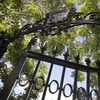{shortcode-cd0b951980a4cedcb3a1f8b39f962cdd96e4bf91}
After a weeks-long impasse between pro-Palestinian demonstrators and Harvard administrators, Harvard’s encampment finally ended — with a whimper, not a bang.
In exchange for the removal of the tents in Harvard Yard, interim University President Alan M. Garber ’76 gave protesters meetings with University leadership, achieving a peaceful resolution to the 20-day encampment.
While dozens of peer institutions brought in the police — often, meeting peaceful protest with violence — Harvard managed to avoid a crackdown. For that, they deserve credit, as do the protesters for upholding standards of conduct and using security marshalls to ensure the University had no need to disperse the encampment by force.
Still, when it comes to managing peaceful protests, avoiding calling in the police is the bare minimum. For an institution that spends an awful lot of time these days talking about free and open inquiry, the bar is constructive engagement — not waving off the cops.
By this standard, Garber’s performance — which seems to have featured a single meeting with protesters in the encampment’s third week — fell short.
As Garber skillfully maneuvered his way out of confrontation with students, he seems to have evaded meaningful conversation with them too. Protesters and faculty alike have sent email after email to Harvard leadership requesting meetings, with at least a majority seemingly left unanswered.
Indeed, it seems administration is intent on pretending they literally don’t exist: In a meeting with faculty last week, interim Provost John F. Manning ’82 had the temerity to suggest that Garber was, somehow, not “aware of those requests.”
Disruptive protests are a final resort. Knowing the risks to their academic standing and professional prospects, students strike out only when they feel utterly frustrated by the existing channels for conveying their concerns about a cause they hold dear.
In this respect, while Garber may have deftly negotiated the encampment’s end, he also helped create the conditions in which it could form at all.
This detente can be a reset. University leaders should build on the meetings it has promised the protesters, opening up channels of communication to prevent discontent from boiling over as it did throughout the past few months. At the very least, administrators can drop the two-faced pretension that they would engage with protesters if only they’d request meetings.
Whatever the issue at hand, when affiliates have serious concerns, Harvard should practice what it preaches, looking to start a thoughtful, honest dialogue rather than dodging and dissembling.
Of course, this requires keeping student protesters on campus in the first place. We are glad to see Garber’s support for quickly reinstating students placed on involuntary leave, a punishment Harvard appears not to have used on such a scale in decades. Still, three times as many students — more than 60 in total — have disciplinary cases pending before school Administrative Boards, which we hope to see resolved with similar restraint.
Forbearance is particularly warranted given the University’s haphazard execution. Suspending students en masse, the University was overinclusive at best and indiscriminate at worst, sending involuntary leave notices to protesters who had spent little time at the encampment and — in an absolutely stunning show of incompetence — a clearly-identified Crimson reporter.
If these involuntary leaves are anything to go by, we are skeptical that the University has the evidence necessary to uphold the due process rights of students with open cases before the Ad Board. In light of this, and in line with how it has treated past generations of activists, amnesty to the protesters involved in the encampment seems the wisest route for all involved.
Finally, Harvard should think seriously about organizers’ demands. Transparency regarding the University’s investments is a reasonable ask. A Palestine studies center could contribute meaningfully to the school’s academic mission. Divestment from weapons manufacturers is only humane.
And for their part, we hope the coalitions on each side of the Israel-Palestine issue do some self-reflection too. More often than not, students have failed to disavow and detach from their most hateful and extreme peers, to this campus’ disadvantage as well as their own. The end of the encampment and the start of summer break offer an opportunity to change that.
As the proverbial dust settles on the encampment — as the grass regrows in the Yard — the University should consider why protesters formed it in the first place. The tents may be gone, but they are still here. Garber would do well to engage them.
This staff editorial solely represents the majority view of The Crimson Editorial Board. It is the product of discussions at regular Editorial Board meetings. In order to ensure the impartiality of our journalism, Crimson editors who choose to opine and vote at these meetings are not involved in the reporting of articles on similar topics.
Have a suggestion, question, or concern for The Crimson Editorial Board? Click here.
Read more in Opinion
To Be a Harvard Man












